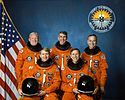STS-38
| Missionsemblem | |||||
|---|---|---|---|---|---|
 | |||||
| Missionsstatistik | |||||
| Missionsnavn: | STS-38 | ||||
| Rumagentur: | NASA | ||||
| Rumfærge: | Atlantis (7) | ||||
| Antal besætningsmedlemmer: | 5 | ||||
| Affyringsrampe: | LC-39A (KSC) | ||||
| Opsendelse: | 15. november 1990 | ||||
| Landing: | 20. november 1990 | ||||
| Landet på: | KSC | ||||
| Varighed: | 4 døgn og 21 timer | ||||
| Foto af besætningen | |||||
 | |||||
| Navigation | |||||
| |||||
STS-38 (Space Transportation System-38) var rumfærgen Atlantis 7. rumfærge-mission. Den blev opsendt d. 15. november 1990 og vendte tilbage den 20. november 1990.
Missionen medbragte klassificeret militær last for Forsvarsministeriet (USA) (DoD).
Hovedartikler:
Besætning

 Richard Covey (kaptajn)
Richard Covey (kaptajn)
 Frank Culbertson (pilot)
Frank Culbertson (pilot)
 Robert Springer (1. missionsspecialist)
Robert Springer (1. missionsspecialist)
 Carl Meade (2. missionsspecialist)
Carl Meade (2. missionsspecialist)
 Charles Gemar (3. missionsspecialist)
Charles Gemar (3. missionsspecialist)
Missionen
Missionen medbragte følgende nyttelast:
- Hemmelig militær last.
- Magnum ELINT (USA-67) spionsatellit [1] [2].
Eksterne henvisninger
- STS-38 NASA (engelsk)
- STS-38 Arkiveret 27. maj 2010 hos Wayback Machine NASA KSC (engelsk)
- ^ NSSDC ID: 1990-097B Arkiveret 11. februar 2017 hos Wayback Machine NASA
- ^ Magnum Chronology www.astronautix.com
| ||||||||
Medier brugt på denne side
STS-41 Mission Insignia
The Space Shuttle Columbia (left), slated for mission STS-35, is rolled past the Space Shuttle Atlantis on its way to Pad 39A. Atlantis, slated for mission STS-38, is parked in front of bay three of the Vehicle Assembly Building following its rollback from Pad 39A for repairs to the liquid hydrogen lines. First motion of Atlantis from the pad was at 10:14 p.m. August 8. It arrived at the VAB at 4 a.m. August 9. First motion of Columbia leaving the VAB for the pad was at 5:47 a.m. Columbia is due to arrive at the pad at noon August 9. Once Columbia is hard down at the pad, Atlantis will be moved into the VAB for destack operations. When Columbia reaches the pad, its payload bay doors will be opened and servicing of the ASTRO-1 payload will begin. Also, portions of the Shuttle interface verification test not completed in the VAB will be conducted.
The official STS-38 crew portrait includes the following 5 astronauts (front left to right): Frank L. Culbertson, pilot; and Richard O. Covey, commander. Standing (left to right) are mission specialists (MS) Charles D. (Sam) Gemar, (MS-3), Robert C. Springer, (MS-1), and Carl J. Meade, (MS-2). The seventh mission dedicated to the Department of Defense (DOD), the STS-38 crew launched aboard the Space Shuttle Atlantis on November 15, 1990 at 6:48:15 pm (EST).
Space Shuttle Atlantis takes flight on its STS-27 mission on December 2, 1988, 9:30 a.m. EST, utilizing 375,000 pounds thrust produced by its three main engines. The STS-27 was the third classified mission dedicated to the Department of Defense (DoD). After completion of mission, Orbiter Atlantis landed December 6, 1988, 3:36 p.m. PST at Edwards Air Force Base, California.
STS-35 Mission Insignia
STS-38 Mission Insignia
Forfatter/Opretter: Kwamikagami, Licens: CC BY-SA 4.0
symbol of Mars. 16 × 16 pixel nominal dimensions, lines 2 pixel thick, square caps. Colour 75% blue: red=0 green=0 blue=191 (#0000BF).
The aft bulkhead of Atlantis' payload bay is seen in this photograph from mission STS-38. The absence of the support equipment for the IUS confirms that the payload of this classified flight was not one of the Magnum satellites.











